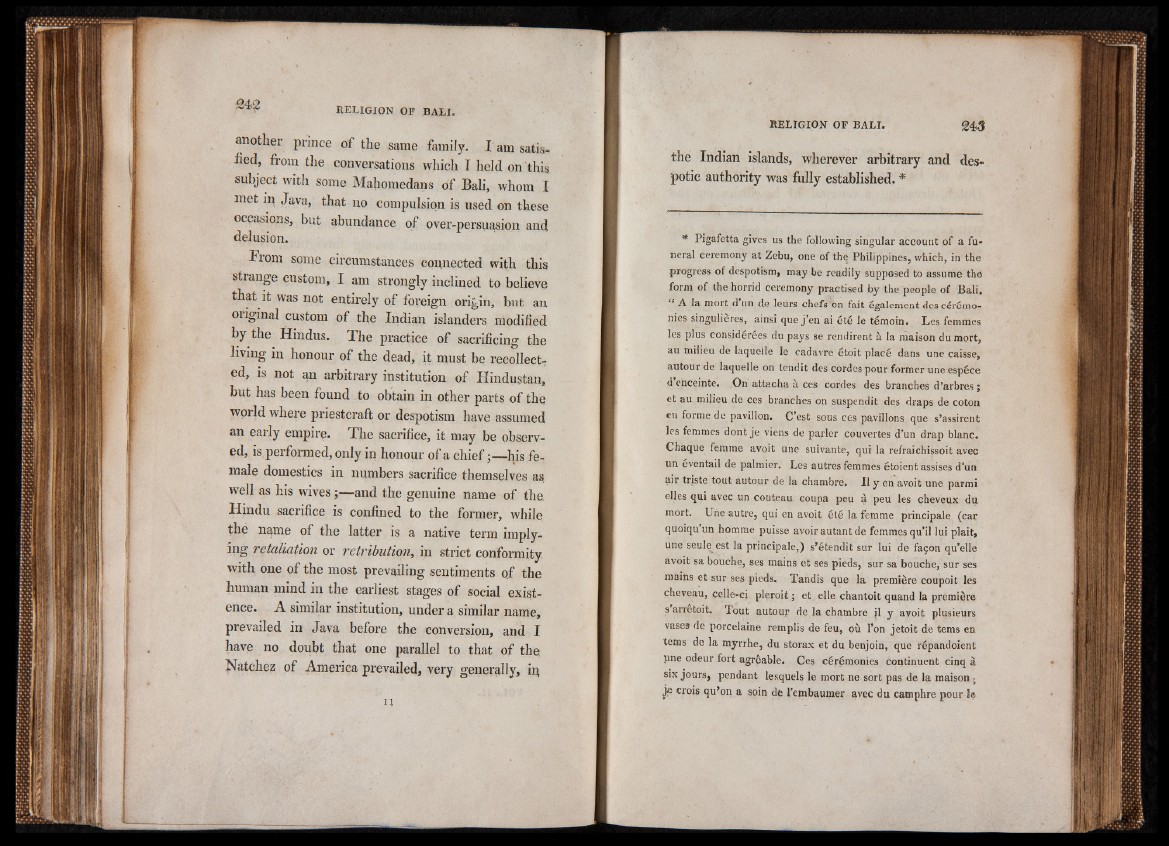
another prince of the same family. I am satis-
lied, from the conversations which I held on this
subject with some Mahomedans of Bali, whom I
met m Java, that no compulsion is used on these
occasions, but abundance of over-persuasion and
delusion.
From some circumstances connected with this
strange custom, I am strongly inclined to believe
that it was not entirely of foreign origin, but an
original custom of the Indian islanders modified
by the Hindus. The practice of sacrificing the
living in honour of the dead, it must be recollect-:
ed, is not an arbitrary institution of Hindustan,
but has been found to obtain in other parts of the
world where priestcraft or despotism have assumed
an early empire. The sacrifice, it may be observed,
is performed, only in honour of a chief;—his female
domestics in numbers sacrifice themselves as
well as his w i v e s a n d the genuine name of the.
Hindu sacrifice is confined to the former, while
the name of the latter is a native term implying
retaliation or retribution, in strict conformity
with one of the most prevailing sentiments of the
human mind in the earliest stages of social existence.
A similar institution, under a similar name,
prevailed in Java before the conversion, and I
have no doubt that one parallel to that of the
Hatchez of America prevailed, very generally, in
n
the Indian islands, wherever arbitrary and despotic
authority was fully established. *
* Pigafetta gives us the following singular account of a funeral
ceremony at Zebu, one of the Philippines, which, in the
progress of despotism, may be readily supposed to assume the
form of the horrid ceremony practised by the people of Bali.
“ A la mort d un tie leurs chefs on fait également des cérémonies
singulières, ainsi que j’en ai été le témoin. Les femmes
les plus considérées du pays se rendirent à la maison du mort,
au milieu de laquelle le cadavre étoit placé dans une caisse,
autour de laquelle on tendit des cordes pour former une espèce
d enceinte. .On attacha à ces cordes des branches d’arbres ;
et au milieu de ces branches on suspendit des draps de coton
en forme de pavillon. C’est sous ces pavillons que s’assirent
les femmes dont je viens de parler couvertes d’un drap blanc.
Chaque iemme avoit une suivante, qui la refraichissoit avec
un eventail de palmier. Les autres femmes étoient assises d’un
air triste tout autour de la chambre. Il y en avoit une parmi
elles qui avec un couteau coupa peu à peu les cheveux du
mort. Une autre, qui en avoit été la femme principale (car
quoiqu un homme puisse avoir autant de femmes qu’il lui plait,
une seule.est la principale,) s’étendit sur lui de façon qu’elle
avoit sa bouche, ses mains et ses pieds, sur sa bouche, sur ses
mains et sur ses pieds. Tandis que la première coupoit les
çheveau, celle-cj pleroit ; et elle chantoit quand la première
s arretoit. Tout autour de la chambre il y avoit plusieurs
vases de porcelaine remplis de feu, où l’on jetoit de tems en
tems de la myrrhe, du storax et du benjoin, que répandoient
une odeur fort agréable. Ces cérémonies continuent cinq à
six jours, pendant lesquels le mort ne sort pas de la maison -
je crois qu’on a soin de l’embaumer avec du camphre pour le